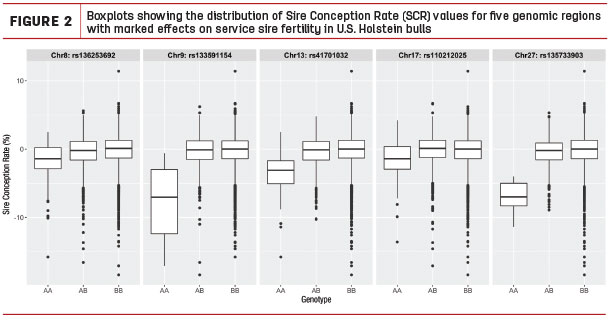However, despite these advances, reproductive efficiency of dairy cattle remains suboptimal, resulting in significant economic losses for the dairy industry. Bull infertility is often overlooked as a potential cause of reproductive inefficiency.
This appears to be contradictory considering that semen from one service sire bull is used to inseminate hundreds of cows and, hence, one subfertile bull would have a larger impact on the overall herd fertility than a single cow with fertility problems. Indeed, some studies have revealed that a significant percentage of reproductive failure in dairy cattle is attributable to service sire subfertility.
Dairy bull fertility has been traditionally evaluated in the laboratory using different semen production and quality attributes, such as sperm morphology, sperm concentration and sperm motility. Unfortunately, these sperm quality traits explain only part of the differences observed in fertility among dairy sires.
Alternatively, bull fertility can be directly evaluated using conception rate records. In this sense, since August 2008, the U.S. dairy industry has access to a national phenotypic evaluation of service sire fertility called Sire Conception Rate (SCR). This bull fertility evaluation is based on a large, nationwide database of confirmed pregnancy records. The current evaluation model includes both factors related to the service sire under evaluation (including age of the bull and A.I. organization) and also factors (nuisance variables) associated with the cow that receives the unit of semen (including herd year season, cow age, parity and milk yield).
The trait SCR is defined as the expected difference in conception rate of a given bull compared to the mean of all other evaluated bulls; for instance, a bull with an SCR value of +5.0 percent is expected to achieve a conception rate of 36 percent in a herd that normally averages 31 percent and uses average SCR bulls. Contrary to evaluations for other traits such as milk production or cow fertility, SCR is designed as a phenotypic rather than a genetic evaluation because the published estimates include not only genetic but also non-genetic effects.
Currently, there are about 13,500 Holstein bulls and 1,800 Jersey bulls with official SCR evaluations. Figure 1 shows the distribution of SCR values in these two breeds.
 Interestingly, there is a remarkable variation in SCR both in Holsteins and in Jerseys; indeed, there are more than 10 points (10 percent conception rate difference) between the two extremes, i.e., between high-fertility and low-fertility bulls.
Interestingly, there is a remarkable variation in SCR both in Holsteins and in Jerseys; indeed, there are more than 10 points (10 percent conception rate difference) between the two extremes, i.e., between high-fertility and low-fertility bulls.
Our group has been investigating potential genetic factors underlying this variation. For instance, we recently identified five genomic regions in U.S. Holsteins that have major effects on service sire fertility (Figure 2).

Click here or on the image above to view it at full size in a new window.
Each of these five genetic variants explain between 3 and 8 percent of the observed differences in conception rates between AB/BB and AA Holstein bulls. Overall, our research findings suggest dairy bull fertility is influenced by genetic factors, and hence it could be managed and improved by genetic means.
SCR is a valuable tool for improving reproductive efficiency in dairy cattle. However, it should be noted that about 80 percent of semen available in the market comes from young genomic-tested bulls, and these young animals typically do not have an SCR record yet given that the SCR evaluation is exclusively based on cow field data. In this context, our group has been exploring the possibility of predicting service sire fertility using genomic information.
This would allow us to predict bull fertility at an early age, even before the animal reaches puberty. Our findings are very promising: We have reported predictive correlations between observed SCR and predicted SCR up to 40 percent in Holsteins and up to 32 percent in Jerseys. Note, the prediction of unobserved genetic values or yet-to-be observed phenotypes is extremely challenging and, hence, our results are very auspicious. Indeed, these genomic predictions are similar or even more accurate than those obtained for some important traits currently evaluated in the U.S., such as metritis or sire calving ease.
Overall, service sire has been now recognized as an important factor affecting herd fertility. In fact, semen from a single sire can be used to inseminate hundreds of cows and, therefore, the fertility of the service sire should not be overlooked. Our recent findings suggest genomic prediction of dairy bull fertility is feasible. This is the foundation for the development of novel genomic strategies that can help the dairy industry make accurate genome-guided decisions, such as early culling of predicted subfertile bull calves. ![]()
Francisco Peñagaricano is an Assistant Professor of Dairy Cattle Genetics and Genomics with the Department of Animal Sciences University of Florida. Email Francisco Peñagaricano.




